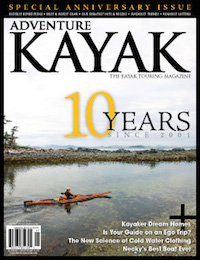Our group was camped on a remote surf beach exposed to the west coast swells off Clayoquot Sound in British Columbia, making a video on weather for sea kayakers. We had chosen that location because it offered an unobstructed, picturesque view of the weather systems as they moved in off the Pacific.
In the far corner of the beach a small gray cabin was tucked into old growth forest, high on a bank above a small boathouse. Salal crowded against the walls and untrampled grass grew up to the doorways. The house was built of driftwood posts and sun-bleached shakes split from huge cedars that lay piled along the hightide line. Its interior resembled the cabin of a wooden ship. Sixteen-foot-high windows faced south into what had once been a garden, now congested with alder and salal. To the north, panorama windows looked over the beach and the northern coastline dotted with tiny islands. Adjacent to the house was a large workshop in need of repair.
I took photographs then returned to my friends on the beach.
“Well, I’ve found my dream place,” I announced. On the water and off the grid.
Bea was remarkably sanguine about giving up her job and moving to the wilds when I showed her the pictures back in Vancouver. It was exactly what we had been looking for. We tracked down the owner (who loathed kayakers) and convinced him to rent to us.
We enjoyed the hard work that first year: clearing the vegetation around the house, bringing back the old gardens, rebuilding the workshop and then adding a guest cabin. Our first winter project after getting the place in order, and six chords of firewood drying in the wood- shed, was to build a small lapstrake sailboat from beach lumber. The next year we opted for rocking chairs! Now, five years in, we spend our time doing the sorts of things we have been putting off for years: writing and painting the stunning land- scapes we can see from our porch and looking after two dogs, two cats and three laying hens.
During the summer and fall we catch two or three coho or spring salmon each day by wading into the water and casting out a Buzz Bomb. Although our nearest neighbor is some four hours’ walk away, and the trip to town takes two hours by kayak, it is by no means a lonely spot. The beach is popular with kayakers which makes
for a lively summer social scene. From October through to April, however, there are no visitors besides family and a few hardy friends. Storms parade by and the nights are long. We love it.
Cell phone reception can be a problem (we have to walk a quarter mile) and we lost Internet access when Telus fiddled with the local trans- mission tower. For our weekly run to town we now use a rigid inflatable with a 30-horsepower engine, but breaking out through surf with an inflatable can be problematic, and when it is too big, kayaks are the only way to go.
John Dowd is one of the founders of the sport of sea kayaking and wrote the classic guide Sea Kayaking: A Manual for Long-Distance Touring, now in its fifth edition. John and Bea Dowd paddled from Venezuela to Florida in 1977.




